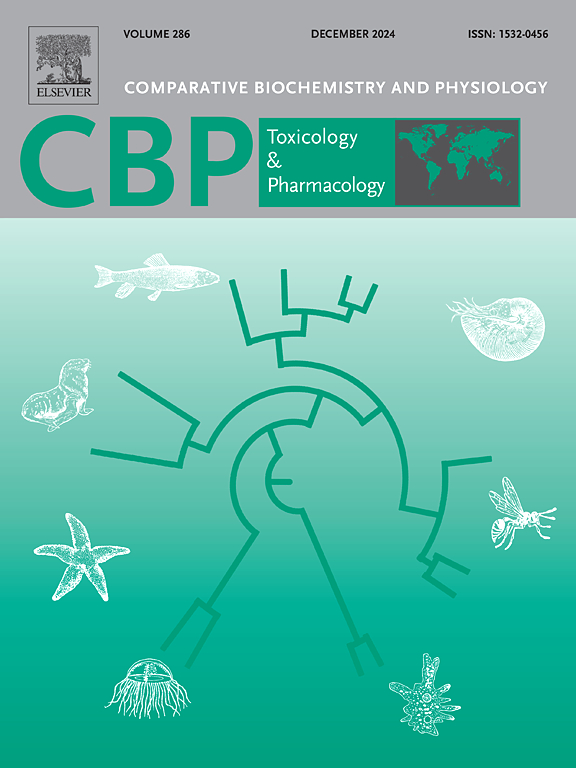d -氰菊酯诱导斑马鱼胚胎发育过程中的心环衰竭
IF 3.9
3区 环境科学与生态学
Q2 BIOCHEMISTRY & MOLECULAR BIOLOGY
Comparative Biochemistry and Physiology C-toxicology & Pharmacology
Pub Date : 2025-03-12
DOI:10.1016/j.cbpc.2025.110193
引用次数: 0
摘要
心环是胚胎发育过程中的一个重要过程。心环异常或衰竭可导致先天性心脏缺陷,从而影响正常的生理功能。环境污染物暴露是心循环衰竭的主要原因之一。D-tetramethrin是一种广泛应用于家庭和公共场所的卫生杀虫剂,可通过接触、虫媒传播和食物链进入人体,影响人体健康。本研究将斑马鱼胚胎暴露于不同浓度的d -氰菊酯中,分析其对胚胎心脏发育和氧化应激水平的影响。此外,采用qPCR分析心脏发育和功能相关基因的转录和表达水平。结果表明:(1)d -氰菊酯暴露可显著降低大鼠心率,增加静脉窦与动脉球之间的距离(SV-BA),提示d -氰菊酯诱发心循环衰竭,导致心功能异常。(2) D-tetramethrin暴露可提高斑马鱼胚胎中活性氧(ROS)和丙二醛(MDA)水平,降低过氧化氢酶(CAT)和超氧化物歧化酶(SOD)等关键抗氧化应激酶的酶活性。(3) d -四氯菊酯暴露导致心脏环相关基因(Myh6、Nkx2.5、Tbx2b、Tbx5a、Tnnt2c和Hand2)和心脏功能相关基因(Gata4、Vmhc和Nppa)的转录显著下调。我们的研究结果表明,d -胺菊酯引起ROS的积累,进而改变心环相关基因的转录水平,最终导致心环衰竭。本文章由计算机程序翻译,如有差异,请以英文原文为准。

D-tetramethrin induces cardiac looping failure in zebrafish during embryonic development
Cardiac looping is a crucial process during embryonic development. Abnormalities or failures in cardiac looping can lead to congenital heart defects, thereby affecting normal physiological function. Environmental pollutant exposure is one of the major causes of cardiac looping failure. D-tetramethrin is a hygienic insecticide widely used in households and public places, that can enter the human body through contact, insect transmission, and the food chain, thereby impacting human health. In this study, zebrafish embryos were exposed to different concentrations of D-tetramethrin to analyze its effects on heart development, and oxidative stress levels within the embryos. Additionally, qPCR was employed to analyze the transcription and the expression levels of genes related to heart development and function. The results showed that (1) D-tetramethrin exposure significantly reduced heart rate and increased the distance between the sinus venosus and the bulbus arteriosus (SV-BA), which suggested that D-tetramethrin induced cardiac looping failure and led to abnormal heart function. (2) D-tetramethrin exposure elevated the levels of reactive oxygen species (ROS) and malondialdehyde (MDA) in zebrafish embryos while decreasing the enzyme activities of key antioxidant stress enzymes, such as catalase (CAT) and superoxide dismutase (SOD). (3) D-tetramethrin exposure resulted in a significant downregulation of the transcription of cardiac looping-related genes (Myh6, Nkx2.5, Tbx2b, Tbx5a, Tnnt2c and Hand2) and heart function-related genes (Gata4, Vmhc and Nppa). Our findings indicate that D-tetramethrin causes the accumulation of ROS, which in turn alters the transcription levels of genes related to cardiac looping, ultimately resulting in cardiac looping failure.
求助全文
通过发布文献求助,成功后即可免费获取论文全文。
去求助
来源期刊
CiteScore
7.50
自引率
5.10%
发文量
206
审稿时长
30 days
期刊介绍:
Part C: Toxicology and Pharmacology. This journal is concerned with chemical and drug action at different levels of organization, biotransformation of xenobiotics, mechanisms of toxicity, including reactive oxygen species and carcinogenesis, endocrine disruptors, natural products chemistry, and signal transduction with a molecular approach to these fields.

 求助内容:
求助内容: 应助结果提醒方式:
应助结果提醒方式:


